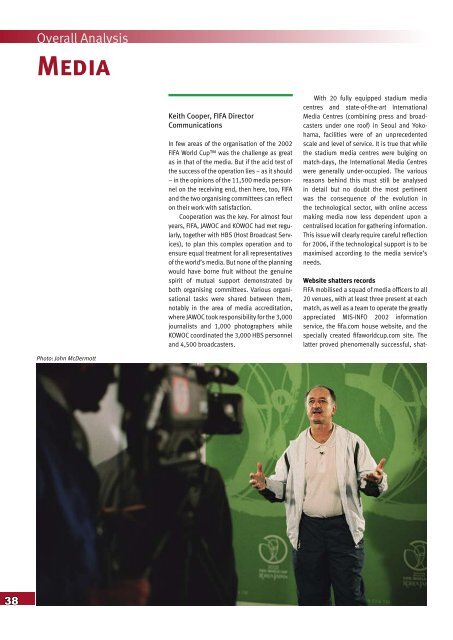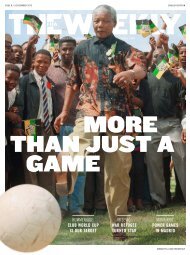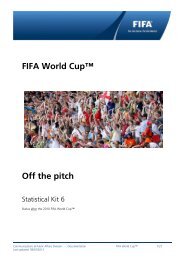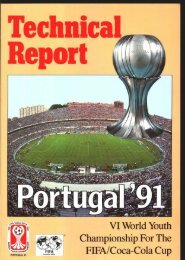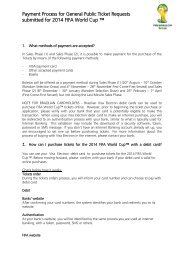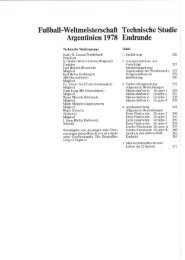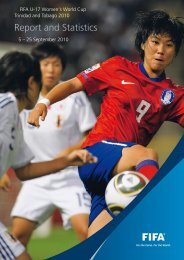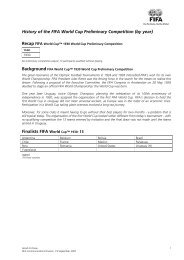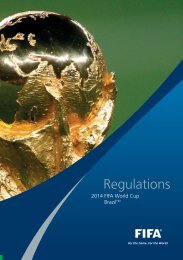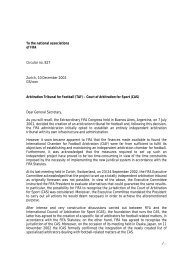You also want an ePaper? Increase the reach of your titles
YUMPU automatically turns print PDFs into web optimized ePapers that Google loves.
38<br />
<strong>Overall</strong> <strong>Analysis</strong><br />
Media<br />
Photo: John McDermott<br />
Keith Cooper, <strong>FIFA</strong> Director<br />
Communications<br />
In few areas of the organisation of the 2002<br />
<strong>FIFA</strong> World Cup was the challenge as great<br />
as in that of the media. But if the acid test of<br />
the success of the operation lies – as it should<br />
– in the opinions of the 11,500 media personnel<br />
on the receiving end, then here, too, <strong>FIFA</strong><br />
and the two organising <strong>com</strong>mittees can reflect<br />
on their work with satisfaction.<br />
Cooperation was the key. For almost four<br />
years, <strong>FIFA</strong>, JAWOC and KOWOC had met regularly,<br />
together with HBS (Host Broadcast Services),<br />
to plan this <strong>com</strong>plex operation and to<br />
ensure equal treatment for all representatives<br />
of the world’s media. But none of the planning<br />
would have borne fruit without the genuine<br />
spirit of mutual support demonstrated by<br />
both organising <strong>com</strong>mittees. Various organisational<br />
tasks were shared between them,<br />
notably in the area of media accreditation,<br />
where JAWOC took responsibility for the 3,000<br />
journalists and 1,000 photographers while<br />
KOWOC coordinated the 3,000 HBS personnel<br />
and 4,500 broadcasters.<br />
With 20 fully equipped stadium media<br />
centres and state-of-the-art International<br />
Media Centres (<strong>com</strong>bining press and broadcasters<br />
under one roof) in Seoul and Yokohama,<br />
facilities were of an unprecedented<br />
scale and level of service. It is true that while<br />
the stadium media centres were bulging on<br />
match-days, the International Media Centres<br />
were generally under-occupied. The various<br />
reasons behind this must still be analysed<br />
in detail but no doubt the most pertinent<br />
was the consequence of the evolution in<br />
the technological sector, with online access<br />
making media now less dependent upon a<br />
centralised location for gathering information.<br />
This issue will clearly require careful reflection<br />
for 2006, if the technological support is to be<br />
maximised according to the media service’s<br />
needs.<br />
Website shatters records<br />
<strong>FIFA</strong> mobilised a squad of media officers to all<br />
20 venues, with at least three present at each<br />
match, as well as a team to operate the greatly<br />
appreciated MIS-INFO 2002 information<br />
service, the fifa.<strong>com</strong> house website, and the<br />
specially created fifaworldcup.<strong>com</strong> site. The<br />
latter proved phenomenally successful, shat-


